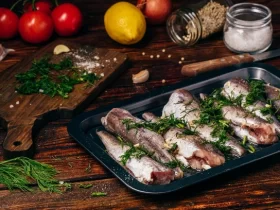How To Cook Eggplant In Pan
If you’re in the mood for a delicious and nutritious meal, look no further than eggplant cooked in a pan. Not only is this versatile vegetable packed with flavor, but it’s also easy to prepare and can be enjoyed in a variety of ways. Whether you’re a seasoned cook or a beginner in the kitchen, we’ve got you covered with this simple guide on how to cook eggplant in a pan.
1. Choose the Right Eggplant
When it comes to cooking eggplant in a pan, it’s essential to select the right one for the best results. Look for firm and glossy eggplants with smooth skin. Avoid those with bruises or blemishes, as they might not taste as good or cook evenly.
2. Prep and Slice
Before you start cooking, it’s important to prep your eggplant. Begin by washing it thoroughly and removing the stem. Depending on your recipe and personal preference, you can either peel the skin or leave it on. Then, slice the eggplant into even rounds or cubes, ensuring they are of consistent thickness to promote even cooking.
3. Salt and Drain
To remove any bitterness, many people like to salt their eggplant slices before cooking. Sprinkle some kosher salt on both sides and leave them to drain in a colander for about 30 minutes. This process helps to draw out excess moisture and enhances the texture and taste of the cooked eggplant.
4. Choose Your Pan and Heat the Oil
When it comes to cooking eggplant, a non-stick pan or a well-seasoned cast-iron skillet works best. Heat a few tablespoons of olive oil or your preferred cooking oil over medium heat. The oil should generously coat the bottom of the pan without being excessive.
5. Cook the Eggplant
Add the sliced eggplant to the heated pan, making sure not to overcrowd it. Cook the eggplant in batches if necessary. Allow the eggplant to cook undisturbed for a few minutes until golden brown on one side. Gently flip the slices or cubes using a spatula or tongs and cook the other side until tender and nicely browned.
6. Season and Garnish
Once the eggplant is cooked to perfection, it’s time to season and garnish. You can add flavors like garlic, herbs, spices, or your favorite sauce to enhance the taste. Sprinkle some salt and pepper to season, and if desired, top it off with fresh herbs like parsley or basil.
7. Serve and Enjoy
Your deliciously cooked eggplant is now ready to be served! You can enjoy it as a side dish, incorporate it into pasta dishes or salads, or even use it as a topping for pizzas or sandwiches. Get creative and savor the unique and delicate flavors of the eggplant.
Now that you’ve learned how to cook eggplant in a pan, you can easily incorporate this versatile vegetable into your culinary repertoire. With its delicious taste and numerous health benefits, eggplant is a wonderful addition to any meal. So grab a pan, get cooking, and enjoy the wonders of cooking with eggplant!
Cooking eggplant in a pan opens up a world of flavorful possibilities. For those looking to experiment, try Eggplant and Mushroom Stir-Fry for a hearty, umami-packed dish. Eggplant and Tofu Stir-Fry is a great choice for a protein-rich, vegetarian option. Stir-Fried Eggplant with Garlic Sauce offers a punch of flavor with minimal effort. If you love fresh herbs, Sautéed Eggplant with Basil and Tomatoes combines juicy tomatoes and aromatic basil for a simple yet satisfying meal.
For a Mediterranean twist, Eggplant Caponata brings together sweet and tangy flavors in a versatile dish. If you’re a fan of spicy food, Spicy Pan-Fried Eggplant with Ginger adds a delightful kick. Lastly, Pan-Fried Eggplant with Lemon and Herbs is perfect for those who appreciate the zesty freshness of lemon combined with earthy herbs.
-
What are some different ways to cook eggplant in a pan?
There are several delicious ways to cook eggplant in a pan. Some popular methods include roasting, sautéing, stir-frying, and pan-frying. Each method offers a unique flavor and texture to the eggplant.
-
Should I peel the eggplant before cooking it in a pan?
The decision to peel the eggplant before cooking it in a pan depends on personal preference and the recipe you are following. Some people prefer to keep the skin on as it adds a slightly chewy texture and can hold the shape better during cooking. However, if you find the skin too tough or prefer a softer texture, peeling the eggplant is recommended.
-
How do I remove the bitter taste from eggplant when cooking it in a pan?
Eggplants can have a slightly bitter taste, especially if they are not fresh. To remove the bitterness, you can sprinkle salt over the sliced or diced eggplant and let it sit for about 30 minutes. This technique, known as “sweating,” helps to draw out the excess moisture and bitterness. Rinse the salted eggplant well before patting it dry and proceeding with your chosen cooking method.
-
How do I prevent eggplant from becoming too mushy when cooking it in a pan?
Eggplant has a high water content, which can sometimes lead to a mushy texture if not cooked properly. To prevent this, it is essential to cook the eggplant over medium to high heat and avoid overcrowding the pan. Cooking in a single layer and allowing the moisture to evaporate quickly will help achieve a firmer and more desirable texture.
-
Can I use any type of pan to cook eggplant?
Yes, you can use various types of pans to cook eggplant. A non-stick skillet or a regular frying pan works well for most recipes. Cast iron pans are also suitable as they distribute heat evenly. Regardless of the pan you choose, ensure it is adequately heated before adding the eggplant, as this will help to prevent sticking and promote even cooking.










Leave a Reply